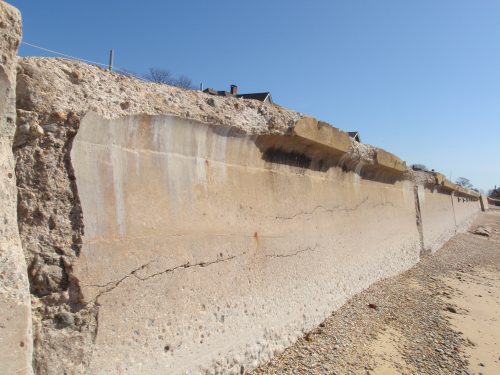“Hard” engineering structures like seawalls limit the natural ability of beach and dune systems to adjust to changes in sediment supply and short-term (seasonal and storm-related) and long-term (sea level rise) changes in coastal water levels through sediment exchange. Seawalls can also cause increased erosion of the beach and on neighboring properties. In accordance with the Structures, Dredging and Fill Act, in Connecticut seawalls may only be permitted when necessary and unavoidable for the protection of infrastructural facilities, water-dependent uses, or inhabited structures constructed as of January 1, 1995, cemetery or burial grounds, and where there is no feasible, less environmentally damaging alternative and where all reasonable mitigation measures and techniques have been provided to minimize adverse environmental impacts. Construction of a shoreline flood and erosion control structure above the CJL may require permit approval from CT DEEP and local land use commissions.
Coastal management standards do permit repair of existing seawalls and construction of erosion control measures necessary to protect homes; however, a property owner is not entitled to build a new seawall simply to expand or preserve a lot boundary. In addition to the adverse environmental impacts of such structures, the protection they afford is not an inherent property right. Connecticut law has long recognized that natural coastal processes such as erosion or accretion change coastal property boundaries.
In an emergency, a property owner can make temporary fixes to an existing seawall to protect private infrastructure from storm damage. The specific activities are outlined in the Section 22a-363d of the Connecticut General Statues (CGS) which authorizes CT DEEP to issue emergency authorizations for activities subject to the Structures, Dredging and Fill Regulatory Program. Emergency authorizations are limited to situations that pose an imminent, unforeseen and unacceptable threat to life, health or welfare or significant loss of property if corrective action, otherwise requiring a permit or a certificate of permission, is not undertaken. These authorizations can be issued quickly and contain conditions appropriate for the activity. Temporary authorizations are only available for activities for which CT DEEP has been authorized to issue general permits and are relatively short in duration (i.e., less than 90 days). Temporary authorization may only be issued once for a maximum of 90 (whether consecutive or not). If you have questions about an emergency, temporary fix to protect your property, contact local, state and/or federal regulatory officials for advice on applicable regulations before proceeding.
Minor maintenance of existing, authorized or legally installed seawalls is covered by a general permit. Minor repair work includes patching concrete, repointing mortar between stone, resetting fallen stones and applying a skim coat to the face of the seawall. No registration is required to be submitted for the activity to be authorized by the general permit. Any modifications to the design of an existing seawall that will alter the size and location of the structure will require an individual permit. Again, contact local, state and/or federal regulatory officials for advice on applicable regulations before proceeding with seawall maintenance or repair.
If an authorized seawall protecting property is damaged, a coastal property owner may sometimes replace or repair the seawall in-kind and in-place (i.e., same materials, same dimensions as the previously existing structure) with a General Permit issued by CT DEEP. Seawall repair or reconconstruction requires a survey plan prepared by a licensed engineer.
If a property owner proposes to change their seawall, an individual permit would be required.

Seawall needing repair. Photo: Jennifer O'Donnell